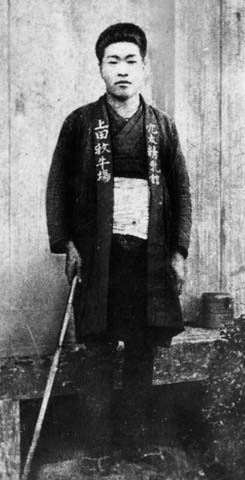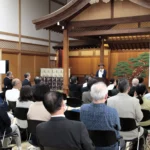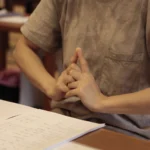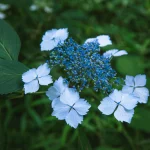By Ruth Reiner
Hi there. Well, in Hebrew we say “change your place, change your luck”, and so this might have just been the case with Onisaburo.
Between the ages of twenty-one and twenty-three, Kisaburo went to live at his cousin’s house in Sonobe (twenty miles West of Kameoka), helping his cousin who was a veterinarian.
Although Kisaburo was very busy working, he always had a passion to learn, and in every free moment he would open a book. At that time a renowned scholar, Korehira Okada, was staying at nearby Nan’yoji Temple and Kisaburo went to him to study the classics of Japanese poetry.

He also learned alot from his veterinarian work. After getting some experience and knowledge Kisaburo decided to go back to Anao, his hometown, and establish a dairy farm of his own. Eventually, the Ueda dairy became a successful enterprise. Those were flourishing years for Kisaburo. He undertook many new hobbies, became addicted to writing – he even started to write for a monthly literary magazine humorous poems and stories. He painted, founded a haiku club, took on folk dancing and drama.
Kisaburo’s haiku teacher gave him the pen-name Dohenkutsu Uhososho Asanebo Kanraku, which means: “Queer Fellow Crow Peak Master Sleepy-head Free-and Easy”, (thank god Japanese words are much shorter, ‘cause I wouldn’t want to actually have to practice that in English, every time I’d call him!). But, Kisaburo adopted the pen-name “Ankambo Kiraku”-”a leisured and carefree man”. Kisaburo became quite a popular young man and made a name for himself locally as a man of culture.
But, since nothing lasts forever, soon Kisaburo’s luck changed again. In 1897, Kisaburo’s father succumbed to an illness of unknown origin. While his father was in the last stages of his illness, Onisaburo, being a devoted son, found himself among many other things managing the dairy farm, taking care of his sick father, and the house hold. He searched in hope to cure his father by faith, visiting shrine after shrine.
At a certain point perhaps out of sorrow for Kisaburo, his father asked him to chop down the tree in the northeast corner of their garden for firewood instead of having to go to the mountains. Six months later his father died.
Later, relatives and acquaintances accused Kisaburo and the him that his father had died because he chopped down the tree in the northeast corner (an unlucky direction), or insisted that it was the curse of the pond. These things got Kisaburo quite angry inside and disgusted with the superstitions.
Besides Kisaburo’s emotional situation, the landlords were knocking at his door demanding payments of his late father’s debts. Kisaburo “born strong and bold, and now with the extra strength of depression” began fighting these people, on the streets or in bars, soon becoming a “Robin Hood” figure in local gangland circles, “as his sympathy toward the weak and his hostility toward the strong became one”. (ch. 3)
“In fact, Kisaburo pledged to become the Chobei Banzuiin of the Meiji Period (Banzuiin was a popular hero who lived in the 17th century and became the subject of a Kabuki play dealing with his exploits in defending the oppressed). (ch. 3)
Onisaburo had survived quite a number of violent situations. But, one day Kisaburo found himself in the midst of a surprise attack. He was beaten so roughly that he laid unconscious “more dead than alive”, the whole night in a small shed in front of a shrine. The next morning his mother and grandmother found him half in coma.
“Kisaburo could not move and even speak. But his own remorse and the concern shown by his mother and grandmother made him deeply ashamed. At the same time a feeling of gratitude welled up inside him when he thought of all the times he had been pulled back from the brink of death or disaster…” (ch. 4)
And maybe since sometimes you have to “hit the bottom” in order to go up again, Kisaburo now started to have some mystical experiences (which would later be recorded in his Reikai Monogatari – Stories from the Spiritual World). These experiences of course changed Kiaburo’s life, starting out with this mysterious story (all from ch. 4):
“According to his account, Kisaburo repeatedly sank into unconsciousness, experiencing a feeling of being sucked down, and when this had happened a number of times, he saw, in his semi-conscious state, a human figure in the shed with him. It was the figure of a man wearing Western cloths, and he began talking to Kisaburo.” After exchanging a few sentences, Kisaburo followed this man, with no clear idea of their purpose. This was on the night of March 1, 1898. He left a note on a roll of paper, that said:
“I am a bird flying in the sky…
Riding on a far, high cloud
I watch, in a trance,
the people in the world below
moving about
caught up in their joys and sorrows.
How funny the world of human beings…“
Where Onisaburo was, and what happened… you will find in next week’s item on “The Great Onisaburo Deguchi”. One thing for sure – this book never failed to surprise me, so stick in there!



